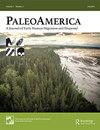巴西晚更新世Toca da Janela da Barra do antoni o - Piauí遗址的形成过程
IF 1.7
Q1 ANTHROPOLOGY
引用次数: 6
摘要
巴西东北部晚更新世遗址的考古研究很少从地质考古学的角度分析遗址的形成过程。这促成了长期以来关于更新世时代的可靠性以及石器和燃烧特征的人为起源的争论。在这项工作中,我们结合高分辨率地质考古方法研究了Toca da Janela da Barra do antonio North遗址(TJBA-North)的形成过程,该遗址位于boqueir本文章由计算机程序翻译,如有差异,请以英文原文为准。
Formation Processes of the Late Pleistocene Site Toca da Janela da Barra do Antonião – Piauí (Brazil)
ABSTRACT Archaeological research of late Pleistocene sites in northeastern Brazil has rarely analyzed site formation processes from a geoarchaeological perspective. This has contributed to the long-held debate over the reliability of Pleistocene ages and the anthropic origin of stone tools and combustion features. In this work, we combine high-resolution geoarchaeological methods to study the formation processes of the Toca da Janela da Barra do Antonião North site (TJBA-North), located in a surface karst about 12 km northeast of the classical site of Boqueirão da Pedra Furada (Serra da Capivara, Piauí). The site contains stone tools and megafauna remains in sedimentary levels that have been dated by optically stimulated luminescence (OSL) as more than 20,000 years ago up to the early Holocene. Using micromorphology, Fourier transform infrared spectrometry (FTIR), micro-FTIR on the micromorphology thin sections, and magnetic analyses, we carried out a comprehensive study of the climatic conditions during the late and terminal Pleistocene and investigated the depositional history of the site.
求助全文
通过发布文献求助,成功后即可免费获取论文全文。
去求助
来源期刊

PaleoAmerica
Earth and Planetary Sciences-Paleontology
CiteScore
3.70
自引率
0.00%
发文量
15
期刊介绍:
PaleoAmerica disseminates new research results and ideas about early human dispersal and migrations, with a particular focus on the Americas. It fosters an interdisciplinary dialog between archaeologists, geneticists and other scientists investigating the dispersal of modern humans during the late Pleistocene. The journal has three goals: First and foremost, the journal is a vehicle for the presentation of new research results. Second, it includes editorials on special topics written by leaders in the field. Third, the journal solicits essays covering current debates in the field, the state of research in relevant disciplines, and summaries of new research findings in a particular region, for example Beringia, the Eastern Seaboard or the Southern Cone of South America. Although the journal’s focus is the peopling of the Americas, editorials and research essays also highlight the investigation of early human colonization of empty lands in other areas of the world. As techniques are developing so rapidly, work in other regions can be very relevant to the Americas, so the journal will publish research relating to other regions which has relevance to research on the Americas.
 求助内容:
求助内容: 应助结果提醒方式:
应助结果提醒方式:


